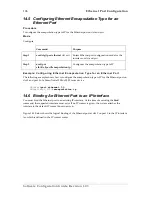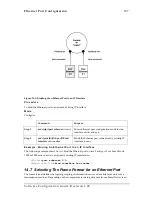
102
NAPT Configuration
Command
Purpose
Step 1
node
(cfg)#profile napt
name
Selects the existing NAPT profile
name
for
modification
Step 2
node
(pf-napt)[
name
]#icmp
default
ip-address
Defines a host in the local network at IP address
ip-address
shall get all ICMP messages from the
global network
Example: Configuring an ICMP Default Server
The following example shows how to configuring the ICMP defaults server. The host in the local
network at IP address
192.168.1.20
shall get all ICMP messages from the global network. Use the
following commands in configuration mode.
SN(cfg)#
profile napt access
SN(pf-napt)[access]#
icmp default 192.168.1.20
13.8 Removing an ICMP Default Server
Procedure
To remove an ICMP default server in the NAPT profile
name
Mode
Configure
Command Purpose
Step 1
node
(cfg)#profile napt
name
Selects the existing NAPT profile
name
for
modification
Step 2
[
node
(pf-napt)[
name
]#no icmp
default
Removes the default ICMP server entry
Example: Removing an ICMP Default Server
The following example shows how to remove the ICMP default server entry. Use the following
commands in configuration mode.
SN(cfg)#
profile napt access
SN(pf-napt)[access]#
no icmp default
13.9 Configuring an NAPT Interface
This command can be entered in the IP interface mode. It enables NAPT, defines the current interface
to be connected to the global network and binds the specified NAPT profile to the interface. This
command fails if there is already a defined global interface. If this is so, change to the global
interface, unbind the NAPT profile, change back to this interface and retry binding the NAPT profile
to it. Binding a NAPT profile to an interface automatically updates the NAPT part of the router with
the static port translation entries, configured in that profile.
Procedure
Software Configuration Guide, Revision 1.03
To bind the NAPT profile to an interface
Summary of Contents for SmartWare R2.00
Page 2: ......






























